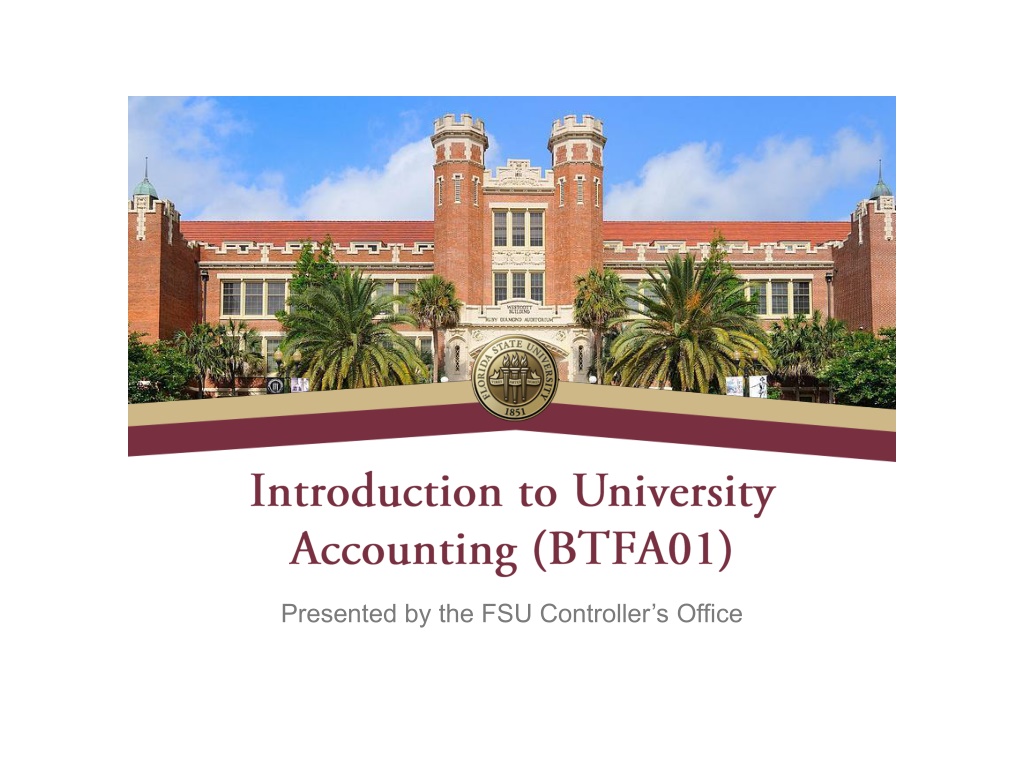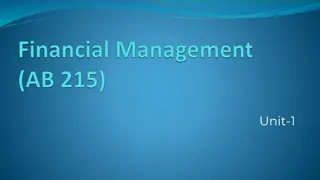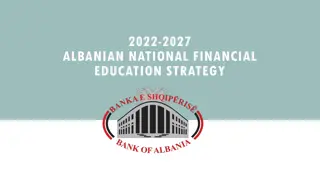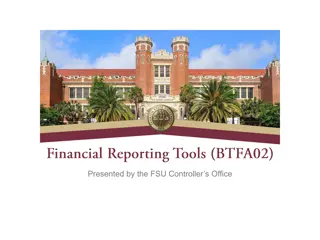Financial Management Processes at FSU
Explore the key roles and responsibilities in university accounting at FSU, including Budget Managers, Financial Representatives, and Deans. Learn about the flow of money, basic accounting concepts, and the interaction between different departments and external entities like State Government and Grantors. Understand the significance of Financials (FI) in storing all financial and accounting information at the university.
Download Presentation

Please find below an Image/Link to download the presentation.
The content on the website is provided AS IS for your information and personal use only. It may not be sold, licensed, or shared on other websites without obtaining consent from the author. Download presentation by click this link. If you encounter any issues during the download, it is possible that the publisher has removed the file from their server.
E N D
Presentation Transcript
Your Role in University Accounting How does the money flow? myFSU Basic Accounting Concepts Ledgers Budget Expenses vs. Encumbrances Available Balance Journal Entries Chartfields Resources
Financial Representatives Loosely defined Budget Managers Authorized Signers Largely those in Budget & Financial Services Job Family Monitor, manage, approve, reconcile, and/or review financial processes and/or data Many wear multiple hats FinRep Listserv
Budget Manager Serves as the official contact for financial matters Ensures that departmental ledgers are reviewed/reconciled to identify and correct erroneous transactions Enters Operating Budgets and maintains positive Available Balances
Dean, Director, Department Head or Chair (DDDHC) Typically delegates budgetary responsibility Holds ultimate responsibility for department operations Authorized Signer Granted authority to approve transactions that impact a department s budget or financial position. Listings available from FSU_DPT_DEPARTMENT_ROLES query in OMNI Financials
State Government (Legislature) Grantors (aka Sponsors) External Customers Students Donors Research Foundation (DSO) Foundation (DSO) FSU Academic / Administrative Departments Auxiliary Departments Foundation Projects Sponsored Projects
Financials (FI) Focus of this class Stores all financial & accounting information of the University Human Resources (HR) Time entry / approval Training signup Security role requests Benefits info, evaluations, job applications, recruiting, etc. Student Central aka Campus Solutions (SC) Enrollment Student financial management
FSU FSU homepage Canvas FSU s learning management system (online courses, course sites, and such) @fsu Webmail portal @my myFSU portal (Office 365) Hyperion (HYP Budget) Hyperion budgeting system SpearMart Online shopping portal Maintained by Procurement Services
FSU Service Center (aka CRM) All help tickets or cases maintained here Oracle Business Intelligence (BI) Oracle data warehouse for reporting Covered extensively in BTFA02 Financial Reporting Tools class Concur FSU travel system Also of note Useful links along the side Important notices along the top My Worklist My Security Center FSU Calendar
Online Management of Networked Information Oracle PeopleSoft Enterprise (ERP) system Implemented in 2004 to replace FLAIR Modular Application Examples of SOME OMNI Modules Accounts Payable Purchasing (interfaces with SpearMart) Travel and Expenses (interfaces with Concur) Commitment Control (interfaces with Hyperion)
Ledger A set of books that stores budgeting and/or accounting transactions Detailed information stored in smaller (subsidiary) ledgers Subsidiary ledgers are summarized and permanently recorded (posted) to one primary ledger called the General Ledger (GL) Transactions that record and post to the GL are called Journal Entries (JEs) and must be in balance (debits = credits) FSU has two main types of ledgers ACTUALS (usually referred to as GL) Contains non-budgetary financial information Primary focus of this class COMMITMENT CONTROL (KK) Contains budgetary transactions and provides a mechanism for controlling expenditures against a pre-defined spending limit
Budget = Authority to spend Departments formulate an annual operating budget for the following fiscal year each April Once approved, budget is booked in the KK ledgers Each department s spending is controlled by their budget
Encumbrance Recorded in KK ledgers only to reflect commitments to spend prior to actual expenditures taking place. Established via: Purchase Orders Travel Requests Payroll Appointments Expenses Recorded in ledgers (and reduce the related encumbrance) once an actual liability has been established via: Voucher Expense Report Payroll * Expenses can also be recorded with a direct cash journal to an expense account (this would bypass any encumbrance)
BUDGET LESS: ENCUMBRANCES LESS: EXPENSES = AVAILABLE BALANCE Available Balance should NEVER be negative.
Transaction GL KK Everything Lines including cash, receivables, payables, revenues, expenses, etc. all post to the GL. Some things Only lines including non- property revenues and non-property expenses post to KK. GL Journal Entries Nothing GL Journal Entries are the only financial transactions that post to the GL. Everything Lines updating budget balances post to the appropriate KK budget ledgers. Budget Journals & Budget Transfers Nothing GL Journal Entries are the only financial transactions that post to the GL. Some things Encumbrances are established when purchase orders or travel requests are issued. Other Purchase Orders, Travel Authorizations, etc.
Used to record ALL transactions in the Ledger Three potential sources of Journals: OMNI Systems Third Party Systems Systems other than PeopleSoft Direct Journal Entries Manually keyed or uploaded journals Each Journal Entry is assigned a unique Journal ID 10 Characters All but direct journals have an alpha prefix Helps to identify journal source E.g. AP, AR, SF Journal Source provides clear indication of where JE originated 2 or 3 characters FSU_DPT_CODES_GL_SOURCE provides a complete list
Human Resources Database (HR) Interfaces summarized accounting information each pay period 3 related Sources PAY Actual payroll charges PNC Payroll encumbrances are re-established each pay period PRV Reverses the encumbrance amount from previous pay period PNC & PRV Sources do NOT record any expenditures; only encumbrances (note Journal Status <> P) Employee-level journal detail available via HR-GL Detail BI report
Student Central Database (SF) Interfaces summarized accounting information nightly from SC Student/class-level detail only available in SC or BI Student Financial Transaction Details report System-generated activity Tuition/fee assessments, payments, financial aid, etc. Recorded in SC via Item Types Item Type Unique ID that drives accounting for specific transaction type
OMNI Financials Module/System Journals All journals will reflect summarized data Transaction details available in each module Accounts Payable (AP) Records voucher-related payables, payments, and cancellations Includes Purchasing Card (PCard) expenses (credit cards issued to department staff for misc. purchases) Voucher-level details available via FSU_DPT_AP or FSU_DPT_GL_JRNL_WITH_VCHR queries BI Expense Data Mining report Travel & Expense (EX) Records all spend interfaced from Concur
OMNI Financials Module/System Journals (cont.) Asset Management (AM) Records all fixed asset-related transactions (asset additions, retirements, transfers, depreciation, etc.) See FSU_DPT_AM queries for asset-level details Accounts Receivable & Billing (AR / BI) Records billing and related receipt transactions for both auxiliary and sponsored project-related entities See FSU_DPT_AUX queries for auxiliary-level details Sponsored Research training covers C&G AR and BI activity as well as Grants Management (GM) and Allocation (ALO) transactions Year-end Closing Journals (CLO) Generated by ERP as part of FYE closing processes Can be ignored for most departmental review purposes
Charges from Facilities AiM system for: Maintenance and janitorial services (OFC, OFG, OFM) Utilities (UTG, UTL) only charged to certain non-E&G departments Recorded monthly Details available through Facilities Financial Services Graduate student matriculation waivers (MAT) Generated from the Office of Graduate Studies Expenses allocated based on individual appointments Journal Line Descr field contains student EMPLID for reference Spendable balance updates from the FSUF system (FDN) Recorded nightly Adjusts FSUF funds spendable balance based on previous day s activity Donor details available at reports.foundation.fsu.edu
Departmental Journals Requested by departmental staff (you!) Journals entered, reviewed, and posted by Controller s Office Detailed guidelines and sample forms available online Two main types Departmental Online Journal Entries (DOL) Used primarily to adjust the ledger for transactions already recorded Requested via DOL Form Never used to correct a payroll journal Interdepartmental Requisitions (AUX) Record the sale of goods/services between two FSU departments Requested via IDR Form Some Auxiliaries are utilizing OMNI AR/Billing functionality and do NOT use IDRs Journal Header Ref field shows selling Department Area
Other Direct Journals Journals entered and originated in the Controller s Office (CON) Includes cash transfers recorded whenever E&G budget transfers are made Journal Class will indicate type of journal (just like DOLs) Departmental Deposits (ARD) Deposits of misc. checks/electronic payments Posted within three business days after receipt Journals entered and originated in Sponsored Research (SRA) Interest earning allocations journals (INV) Journals entered and originated in Payroll (PAO) Primarily payroll deductions for Parking Services, Leach Center, etc. Backup for ALL direct journals is attached to each JE in OMNI OMNI FI > General Ledger > Journals > Journal Entry > Create/Update Journal Entries
A means of breaking down accounting transactions within the system in order to organize and report on the data contained in OMNI Three ChartFields (CFs) required for ALL transactions in OMNI Department ID Fund Code Account Transactions recorded at the Project ID level require additional CFs, depending on the fund source Financials > Setup Financials/Supply Chain > Common Definitions > Design Chartfields > Define Values > Chartfield Values
Represent an area of financial management at FSU OMNI Chartfield DeptID is 6 digits First 3 refer to academic, administrative, or other major area Last 3 refer to specific cost center within that area Specific department information or a complete list of FSU departments via FSU_DPT_CODES_DEPTID query Departments added/maintained by Budget Office Includes department designations (Budget Manager, Authorized Signers, Department Head) 4-OP-D-1 OMNI Departments policy governs
Departments roll up to Areas Areas roll up to Schools/Colleges * Schools/Colleges roll up to Divisions Examples: Department Area School/College Division 189000 (Theatre) 189 College of Fine Arts Academic Affairs (School of Theatre) 029004 029 AVP Financial Services Finance & Administration (Accounting Services) (Controller s Office) 028001 108 (Information Technology Service) Information Technology Service Academic Affairs (NCT Service Auxiliary) * OMNI Schools/Colleges are not always academic
Identifies the source of monies May have various restrictions on use Expenditure Guidelines Often have different reporting requirements OMNI Chartfield Fund Code is a 3 digit numerical code Created/maintained by Controller s Office FSU_DPT_CODES_FUND query of all Fund Codes
State = Education & General (E&G) / Carryforward 110 / 140 Sponsored Research or Contracts & Grants (C&G) 520-570 Customers = Auxiliaries / Designated / Vending 320 / 335 / 620 Students = Class / Activities / Technology Fees 301 / 610 / 615 Donors = Foundation Funds managed by FSU Foundation (FSUF) FSUF (DSO) 599 Research Foundation (DSO) FSU Academic / Administrative Departments Auxiliary Departments Sponsored Projects Foundation Projects
State Funds = Education & General or Carryforward 110 E&G Current FY appropriations Lottery allocation Also tuition & some general fees lumped into allocations to departments 140 Carryforward Unspent prior FY E&G funds College of Medicine and Engineering have their own E&G funds Grantors = Sponsored Research aka C&G (520-570) Contracts, grants, and other research-related monies provided by governments or private entities Further broken down by specific Project ID Sponsored Research Administration (SRA) provides final review and approval of these funds
Customers = Auxiliaries / Vending Auxiliaries (320) Provide essential goods/services to departments, faculty, staff, students, and incidentally to the general public Sales to other FSU Departments = INTERNAL, e.g. ITS providing network services to Chemistry department Facilities providing janitorial services to College of Music Sales to anyone else (student, general public, etc.) = EXTERNAL Vending (620) Vending machine funds allocated to departments
Students = Various Fees 301 Miscellaneous Student Fees Includes fees for class materials & supplies, facility/equipment use, distance learning, and international programs 610 Student Activities Fee 615 Student Technology Fee Others 360 Transportation Access 370 Housing 390 Health 630 Athletics
Donors = Foundation (FSUF) Funds (599) Departmental funds transitioned to OMNI in July 2018 Each individual fund assigned a unique Project ID Each fund has its own spending rules based on donor intent Each Department Area has at least one unique DeptID for their FSUF activity FSUF administrative staff provide final review and approval Construction Funds (8xx) When departments provide their own funding, cash is transferred to an equivalent Construction Fund and managed by Facilities 801/802/826 E&G/CF/Auxiliary-funded DeptID does NOT change with transfer
Used to record, summarize, and/or categorize financial transactions as assets, liabilities, equity, revenue, or expense Created/maintained by Controller s Office Two types of Accounts BUDGETARY record budget NON-BUDGETARY (aka GL) categorize transactions OMNI ChartField Account is 6 digits; the first digit identifies the type of account FSU_DPT_CODES_ACCOUNT
Account Type Example 1st Digit Increase Decrease Current Assets Cash, Receivables 1 Debit Credit Non-current Assets Fixed Assets 2 Debit Credit Current Liabilities Accounts Payable 3 Credit Debit Non-current Liabilities Loans Payable 4 Credit Debit Equity or Fund Balance Unrestricted Net Assets 5 Credit Debit Revenues Auxiliary Sales 6 Credit Debit Expenses Salaries, Office Supplies 7 Debit Credit General Ledger Account Lists Data Dictionary = ALL Accounts Short List = Most commonly used Accounts FSU_DPT_CODES_CATEGORY_BY_ACCT query for Procurement Code to Account Code crosswalk
Required for 3 types of funds Sponsored Projects (Funds 520-570) Created/maintained by SRA Foundation (599) Created/maintained by FSUF Construction (8xx) Created/Maintained by Controller s Office Additional ChartFields are required Activity ID & Analysis Type OMNI Chartfield Project ID Sponsored Project IDs 6 numeric digits Foundation Project IDs 6 characters, starting with F Correspond to fund number in FSUF system Construction Project IDs 9 characters, starting with C
Allow departments to track expenses at a more detailed or customized level Created/maintained by Controller s Office Three available (NOT hierarchical); each is up to 10 characters CHARTFIELD 1 CHARTFIELD 2 CHARTFIELD 3 Consistency is key (not required so have to remember) Examples of current use are tracking spend by: Professor Course Number Theater Production
The fiscal year for FSU is a twelve month Fiscal Year 2017 2017 2017 2017 2017 2017 2017 2017 2017 2017 2017 2017 2018 Acct Period 1 2 3 4 5 6 7 8 9 10 11 12 1 Calendar Month July 2016 Aug 2016 Sept 2016 Oct 2016 Nov 2016 Dec 2016 Jan 2017 Feb 2017 Mar 2017 April 2017 May 2017 June 2017 July 2017 period beginning July 1 and ending June 30 Fiscal months are referred to as periods Many financial reports will refer to accounting period and fiscal year What fiscal year and period are we currently in?
Business Unit Operational division of FSU Defined at the module and GL level General Ledger BU = FSU01 Set ID Defined w/in a BU Help organize data within the system Used to define sets of chartfields, customers, vendors, etc. SHARE
?????????????????????? ?????????????????????? ?????????????????????? ?????????????????????? ?????????????????????? ?????????????????????? ??????????????????????
Controllers Office Website controller.vpfa.fsu.edu Business Management Guide Training & Job Aids Accounting Concepts Forms General Account Lists Recommended Query Listing Other central office websites Budget Office Procurement Services Sponsored Research Human Resources Financial Policies & Procedures
Accounting & Reporting Services GeneralAccounting@admin.fsu.edu 644-5010 CTL-Communication@fsu.edu Slides available at http://controller.vpfa.fsu.edu/training Located under General Ledger training materials























